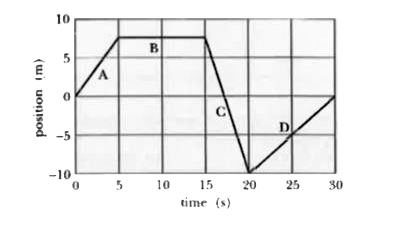An object is moving along a straight line in the positive x direction. The graph shows its position from the starting point as a function of time. Various segments of the graph are identified by the letters A, B, C, and D.

During which interval(s) did the object move in the negative x direction ?
Only during interval B.
During both intervals C and D.
Only during interval C.
Only during interval D.
The correct Answer is:C
Step by step video, text & image solution for An object is moving along a straight line in the positive x direction. The graph shows its position from the starting point as a function of time. Various segments of the graph are identified by the letters A, B, C, and D. During which interval(s) did the object move in the negative x direction ? by Physics experts to help you in doubts & scoring excellent marks in Class 12 exams.
Updated on:21/07/2023Topper's Solved these Questions
- MOTION ALONG A STRAIGHT LINEBook:RESNICK AND HALLIDAYChapter:MOTION ALONG A STRAIGHT LINEExercise:PRACTICE QUESTIONS ( Matrix-Match)
Explore 3 Videos
- MOTION ALONG A STRAIGHT LINEBook:RESNICK AND HALLIDAYChapter:MOTION ALONG A STRAIGHT LINEExercise:PRACTICE QUESTIONS ( Integer Type )
Explore 3 Videos
- MOTION ALONG A STRAIGHT LINEBook:RESNICK AND HALLIDAYChapter:MOTION ALONG A STRAIGHT LINEExercise:PRACTICE QUESTIONS ( More than One Correct Choice Type )
Explore 6 Videos
- MAGNETIC FORCEBook:RESNICK AND HALLIDAYChapter:MAGNETIC FORCEExercise:Practice Questions (Integer type )
Explore 7 Videos
- MOTION IN TWO AND THREE DIMENSIONSBook:RESNICK AND HALLIDAYChapter:MOTION IN TWO AND THREE DIMENSIONSExercise:PRACTICE QUESTIONS (MATRIX-MATCH)
Explore 10 Videos
Similar Questions
Knowledge Check
An object is moving along a straight line in the positive x direction. The graph shows its position from the starting point as a function of time. Various segments of the graph are identified by the letters A, B, C, and D.

What was the instantaneous velocity of the object at the end of the eighth second ?A+7.5 m/sB+9.4 m/sC0 m/sD+9.0 m/sAn object is moving along a straight line in the positive x direction. The graph shows its position from the starting point as a function of time. Various segments of the graph are identified by the letters A, B, C, and D.

Which segment(s) of the graph represent(s) a constant velocity of +1.0 m/s ?AABCCBDDA 2.0 kg object moves in a straight line on a horizontal frictionless surface. The graph in the given figure shows the velocity of the object as a function of time. The various equal time intervals are labeled using Roman numerals: I, II, III, IV, and V.
The net force on the object always acts along the line of motion of the object.

In which section(s) of the graph is the net force changing ?AI and IIIBII and IVCIIIDI and V
An object is in unifrom motion along a straight line . What will be position-time graph for themotion of the object if
(a) x0=+ve,v=+ve (b) x0=+ve,v=−ve(c)x_(0) =- ve, v= + veand(d)⊥hx_(0) and v are negative ? The letters x0 and v position of theobject at time t=0 and v represent posituion of the object at time t=0 and uniform velocity of theobject respectively.
View SolutionAn object is in unifrom motion along a straight line . What will be position-time graph for themotion of the object if
(a) x0=+ve,v=+ve (b) x0=+ve,v=−ve(c)x_(0) =- ve, v= + veand(d)⊥hx_(0) and v are negative ? The letters x0 and v position of theobject at time t=0 and v represent posituion of the object at time t=0 and uniform velocity of theobject respectively.
View SolutionA 2.0 kg object moves in a straight line on a horizontal frictionless surface. The graph in the given figure shows the velocity of the object as a function of time. The various equal time intervals are labeled using Roman numerals: I, II, III, IV, and V.
The net force on the object always acts along the line of motion of the object.

In which section of the graph is the magnitude of the net force decreasing ?
View SolutionA 2.0 kg object moves in a straight line on a horizontal frictionless surface. The graph in the given figure shows the velocity of the object as a function of time. The various equal time intervals are labeled using Roman numerals: I, II, III, IV, and V.
The net force on the object always acts along the line of motion of the object.

Which section of the graph corresponds to the application of the largest constant net force ?
View SolutionThe x-t graph of a particle moving along a straight line is shown in figure

The speed-time graph of the particle is correctly shown by
View Solution



